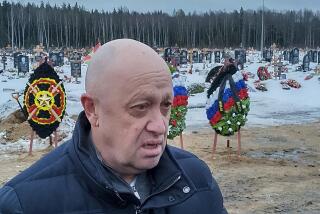Gorbachev Shows Military He’s in Charge, Experts Say
- Share via
MOSCOW — Soviet leader Mikhail S. Gorbachev acted quickly to shake up his defense command “before the military could protect themselves” after the penetration of Soviet air defenses by a teen-aged West German pilot, Western analysts here said Sunday.
“He needed to show them (the military) who is in charge,” one Soviet specialist here commented.
The dismissal of Defense Minister Sergei L. Sokolov and the head of the air defense forces, Chief Marshal Alexander I. Koldunov, came only 48 hours after Mathias Rust, 19, of Hamburg, crossed Soviet territory from Finland and landed a light Cessna aircraft in Red Square, alongside the Kremlin, Thursday evening.
The two were fired and General of the Army Dmitri T. Yazov was named to succeed Sokolov just 24 hours after Gorbachev returned to Moscow with Sokolov from a meeting of Warsaw Pact leaders in East Berlin.
The official Soviet news agency Tass went out of its way Sunday to quote remarks that it said were made in Washington to an American news agency by former U.S. National Security Adviser Zbigniew Brzezinski.
“The Soviets have done what the American high command and political leadership have not had the guts to do--namely, fire the top military when there is a significant setback,” Brzezinski was quoted as saying.
Citing the loss of U.S. Marines in Beirut (where 220 died in a 1983 bomb attack), the recent scandal of the Marine guards at the American Embassy here and the attack on the missile frigate Stark in the Persian Gulf, Tass reported Brzezinski as saying that “not a single person has been fired. I think the Soviets have given us an example of how one asserts responsibility and accountability.”
The quick removal of the two generals and the elevation of Yazov, 63, a little-known figure who was deputy defense minister for personnel, is a measure of the authority that Gorbachev wished to exert before he himself could be blamed for the laxity by the armed forces, Soviet analysts said Sunday.
It is also an indication of the gravity with which the ruling Politburo viewed the intrusion of the West German plane. The Soviet Union has traditionally been keenly defense-minded, and its leaders have been particularly proud of the elaborate air-defense network that surrounds the vast country.
Just last month, Sokolov praised anti-aircraft forces for “vigilantly maintaining armed guard in defense of Soviet air space” in a commendation on Air Defense Forces Day.
The Soviets have a special air defense command, with about 370,000 troops, organized into five districts.
Air defenses reportedly include an anti-ballistic missile system with 100 launchers; about 2,200 interceptor fighter planes, airborne warning and control planes and electronic systems; about 10,000 radar stations; more than 9,000 surface-to-aircraft missile launchers, and a sophisticated anti-aircraft artillery network.
Largest Defense Network
The U.S. defense publication “Soviet Military Power” calls this array “the most extensive strategic defense network in the world.”
All of this notwithstanding, the West German pilot managed to fly through the complex system aimed at protecting Soviet frontiers and, even more amazingly, the Soviet capital itself.
On Sunday, Red Star, the Soviet armed forces newspaper, emphasized that some Soviet military officers had not adapted to calls by Gorbachev for more efficiency--in the military as well as in the economic field.
The paper declared: “Unfortunately, inspection has shown that the necessary reconstruction in thinking and work styles has not yet occurred among many officers, generals, and admirals in the solution of this priority task.”
In a report on the Politburo meeting Saturday that resulted in the shake-up, Tass said the firings showed “the fundamental importance of the task of resolutely enhancing the level of combat readiness and discipline of the armed forces, efficient command of troops and the assurance of their constant capability to cut short any encroachments on the sovereignty of the Soviet State.”
Tass Account Doubted
Tass also said that Rust’s light plane, which crossed the coast from the Gulf of Finland over Estonia, was “detected by radars of the anti-aircraft defense” and that “Soviet fighter planes twice flew around the West German plane.”
However, this account seemed difficult for Western military attaches here to accept. They recalled that after the Soviet Union shot down a South Korean airliner in Soviet air space in 1983, the Kremlin warned that any such violation of their territory in the future would be similarly dealt with.
Western military attaches found it hard to believe Rust’s plane was tracked by Soviet radar and fighter planes and then allowed to fly hundreds of miles across Russia and then circle Moscow, landing in Red Square near Lenin’s mausoleum.
The report from the Politburo meeting, in unusually strong language for Tass, said the air defense command showed “intolerable unconcern and indecision about cutting short the flight of the violator plane without resorting to combat means.”
‘Lack of Due Vigilance’
This situation, the report said, showed “a lack of due vigilance and discipline, major dereliction of duty in the guidance of forces by the U.S.S.R. Defense Ministry.”
Meanwhile, West German diplomats said Sunday that they were officially informed by the authorities that Rust is in custody but that they still have not been allowed to speak to him.
A Soviet public prosecutor is handling the case, and West German diplomats could not immediately learn what charges, if any, will be lodged against Rust.
The Soviets have said that a decision will be made about the young pilot only after an official inquiry is completed. West German diplomats said they hope to see Rust later this week.
Rust reportedly told his Soviet interrogators that he made the flight because he “just wanted to talk to Russians,” according to the West German newspaper Bild.
No replacement for Gen. Koldunov as head of the air defense forces has yet been announced.
More to Read
Sign up for Essential California
The most important California stories and recommendations in your inbox every morning.
You may occasionally receive promotional content from the Los Angeles Times.













